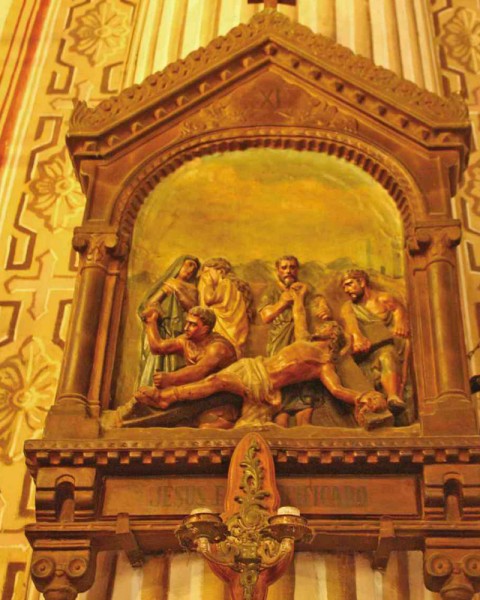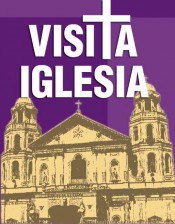Churches to visit north of Manila

The Catholic faithful following the tradition of the Seven Churches Visitation (Visita Iglesia) can find reflection on the Stations of the Cross at St. James The Apostle Church in Betis, Guagua, Pampanga, a four-century-old structure devoted to ecclesiastical art. This sculpture, the eleventh station, shows Jesus being nailed on the cross. E.I. RAYMOND T. OREJAS/INQUIRER CENTRAL LUZON
Devout Catholics in the Philippines go on Visita Iglesia (Spanish for “church visits”) as penance.
Most visit seven churches on Holy Thursday after the evening Mass at the Lord’s supper and after the Holy Eucharist is brought to the “Altar of Repose” by the priest in a procession inside the church.
Holy Thursday is also called Maundy Thursday among non-Catholic denominations. “Maundy” comes from the Latin word, “mandatum” (command) and refers to the episode when Jesus Christ washed the feet of his disciples and commanded them to be good servants.
Holy Thursday is also the start of the three holiest days in Christendom, also called Paschal Triduum, which begins with the evening Mass of the Lord’s supper. Paschal Triduum reaches its high point in the Easter vigil and closes with the evening prayer on Easter Sunday.
During the procession to transfer the Holy Eucharist to the Altar of Repose—a chapel prepared for reservation or a special tabernacle in the church—a eucharistic hymn is sung.
Bells are rung and people kneel in worship. Penitents beat their chests, saying “mea culpa, mea culpa, mea maxima culpa” (through my fault, through my fault, through my most grievous fault).
Under a four-corner canopy hoisted by lay ministers, the priest walks with the ciborium carrying the hosts, covered with white cloth.
Jesus is hidden in the Altars of Repose all over the world until midnight of Thursday. The rite, called the “Transfer of the Blessed Sacrament,” is closely related to the liturgy of Good Friday. The main altar is not used and the tabernacle is empty because Christ is dead.
During Visita Iglesia, the faithful visit either the Altar of Repose or the Stations of the Cross in the church.
Pilgrims can travel to central and northern Luzon’s holiest shrines that offer illumination and some form of adventure.
Visitors can reflect as they visit churches that played major roles in shaping the history and spirituality of the people of central and northern Luzon.
Central Luzon
In Bulacan, pilgrims and travelers may make a first stop at the province’s oldest Roman Catholic church, Saint John the Baptist Church in Calumpit town.
Built in 1572, the church remains sturdy. The church is historic because it was where the venerated Talangpaz sisters, both blessed Filipino nuns and founders of the Congregation of Augustinian Recollect Sisters, were baptized.
Msgr. Andres Valera, vicar general of Malolos diocese, said the Vatican had recognized Dionisia Talangpaz and her sister, Cecilia Rosa, as “Servants of God.”
In Pampanga, the National Museum in 2011 declared Sta. Monica Parish Church in Minalin town a national cultural treasure, the 139th in the country and the second in the province after St. James the Apostle Parish in Betis, Guagua.
Built under the guidance of Augustinians, the Minalin church displays a façade similar to a “retablo” (multilevel niches for images of saints). It holds a 1619 mural that depicts the town’s landscape and keeps an antique La Consolacion painting.
In Bataan, Saint Dominic de Guzman Church in Abucay town, known as the oldest church in the province, is where the Spanish missionaries sowed the seed of Christianity in the province on June 10, 1588.
In Olongapo City, San Roque Chapel was built in 1932 to replace a dilapidated mission church set up by Spanish missionaries.
When the United States put up its naval base in the city, the chapel became the Naval Station Chapel, and is now located within the Subic Bay Freeport.
In Tarlac, the most visited and revered pilgrim site is Monasterio de Tarlac in the uplands of San Jose town, some 30 kilometers from Tarlac City.
Enshrined in the Church of the Risen Christ here is a relic of the True Cross upon which Jesus Christ was crucified.
In Nueva Ecija, the Church of the Three Kings in Gapan City is one of the churches commonly visited by pilgrims not only for being the province’s oldest Catholic church but also for its history and Byzantine architecture. Gapan is 96 km north of Metro Manila.
The church is made of bricks, adobe and lime. Work began in 1740, but it took 16 years to finish it, using forced labor.
In Aurora, San Luis Obispo Parish Church, also known as the Baler Church, was built in 1611 under the supervision of Franciscan missionaries who came to Baler, now the provincial capital, in 1578, wrote Enrique Avanceña in the book, “Amistad Duradera (Enduring Friendship).”
A tsunami in 1735 destroyed the town and church. In its place was built a stone church where 50 Spanish soldiers and a Spanish priest took refuge for 337 days because of a siege by Filipino revolutionaries.
Northern Luzon
Leading the Visita Iglesia sites in the Ilocos region is Our Lady of the Rosary Church, more popularly known as the Shrine of Our Lady of Manaoag, in Pangasinan.
People from other provinces gather at this shrine every Lenten season, but most Pangasinan residents trek on foot on the night of Maundy Thursday, to reach the church at dawn of Good Friday.
The church started as a modest chapel built by the Augustinians in 1600. The construction of the church, which began in 1882, was completed in 1912.
The church was venerated due to an apparition there of the Virgin Mary 400 years ago. An ivory image of the Virgin Mary, brought to the Philippines by Padre Juan de San Jacinto from Spain via Acapulco hundreds of years ago, was enthroned in the church in 1909.
On April 21, 1926, Our Lady of Manaoag was canonically crowned.
In La Union, families on pilgrimage can visit the Church of Our Lady of Namacpacan in Luna town.
Namacpacan was the name given by residents to the Virgin Mary who, according to folklore, appeared to indigenous peoples of the Cordillera as an old woman who offered them food and who convinced them to be baptized.
The Namacpacan church hosts the Virgin’s image which dates back to 1871. The image was ordered from Spain by an Augustinian priest assigned to one of the towns of Ilocos Sur.
In Ilocos Sur, a popular site for pilgrims is Nuestra Señora de la Asuncion Church in Sta. Maria town. It is one of the baroque churches of the Philippines listed in 1993 on the World Heritage List of the United Nations Educational, Scientific and Cultural Organization.
Ilocos Norte’s most popular pilgrimage site is Badoc Church which is home to the miraculous image of the Virgin Mary (La Virgen Milagrosa de Badoc) with the infant Jesus wrapped in her arms.
The Laoag diocese proclaimed the wooden image of La Virgen Milagrosa de Badoc as the patroness of Ilocos Norte on May 2, 1980. Badoc Church was the pilgrimage site of the Great Jubilee Year 2000.
The wooden image, along with the image of the crucified Christ, Sto. Cristo Milagroso, has been venerated for its miracles.
Both images, enclosed in a wooden box, were found washed ashore in the 1620s on the beach of Dadalaquiten that borders Badoc town in Ilocos Norte and Sinait, Ilocos Sur.
Cagayan’s most famous pilgrimage site is Our Lady of Piat Shrine in Piat town, some 40 km from the capital Tuguegarao City.
The shrine was built by Spanish missionaries to pacify the Itawits or Itawes, the native settlers of western Cagayan, in 1604. It was elevated into a basilica minore in 1999.
Historical accounts also showed that the Lady of Piat saved Cagayanos from the 1624 drought.
Tourists and pilgrims have been visiting the shrine in Piat to seek the Lady’s help. The miracles attributed to Our Lady of Piat are recorded in the basilica’s stained glass windows.
In Isabela, an important site for pilgrims is Our Lady of Atocha Church in Alicia town, which has been included in the Department of Tourism’s religious tourist destinations in the country.
The church, made of bricks and features Spanish architecture, was built by Fr. Tomas Calderon and inaugurated in 1849.
Most pilgrimages still end up in Baguio, the summer capital, often at Baguio Cathedral (Our Lady of Atonement Cathedral), which was built in the 1920s.
Other churches
Aside from these 14 churches, pilgrims may also visit other historical churches in central and northern Luzon.
Among these are St. Joseph Cathedral in Balanga City, Bataan; and Malolos Basilica Minore (Malolos Cathedral), Nuestra Señora de la Asuncion Parish Church in Bulakan town, Saint Francis Parish Church in Meycauayan City and Angat Parish Church, all in Bulacan.
In northern Luzon, other important churches are the 406-year-old Bolinao Church, Calasiao Church established in 1596, Our Lady of Lourdes Church in Bugallon, all in Pangasinan; Basilica of Our Lady of Charity, which is a shrine to the Lady of Agoo or the Lady of Charity, in Agoo, La Union; and St. Paul’s Metropolitan Cathedral or Vigan Cathedral in Vigan City, Ilocos Sur.
In Ilocos Norte, some Ilocanos visit nine churches based on the nine-day rosary novena (which requires the devout to pray the rosary for nine consecutive days) while others visit 14 churches to represent the 14 Stations of the Cross.
Other famous Visita Iglesia sites in Ilocos Norte are St. William Cathedral and Carmelite Monastery Chapel (or Carmel Church) in Laoag City; the Catholic churches in the southern towns of Batac, San Nicolas and Paoay, a world heritage structure; other churches found in the eastern towns of Sarrat and Dingras; and Bacarra Church in the north.
Devout Catholics in Cagayan Valley also troop to Our Lady of the Visitation Church in Gamu and St. Matthias Church in Tumauini, both in Isabela; Transfiguration Chapel at Dariuk Hills in Santiago City; and Iguig Church in Cagayan, where concrete statues representing the Stations of the Cross are found in its compound.
The deeply religious Ivatans of the island province of Batanes and tourists spending their Lenten break there visit old Catholic churches spread on several islands.
Among these are Sto. Domingo de Basco Church (Basco Cathedral, built in 1783), San Vicente Church in Sabtang (built in 1844) and St. Joseph the Worker (San Jose) Church in Ivana (built in 1814). Reports from Carmela Reyes-Estrope, Anselmo Roque, Armand Galang, Greg Refraccion, Robert Gonzaga, Jo Martinez-Clemente and Tonette Orejas, Inquirer Central Luzon; and Yolanda Sotelo, Cristina Arzadon, Gabriel Cardinoza, Leoncio Balbin Jr. and Villamor Visaya Jr., Inquirer Northern Luzon; and Inquirer Research
